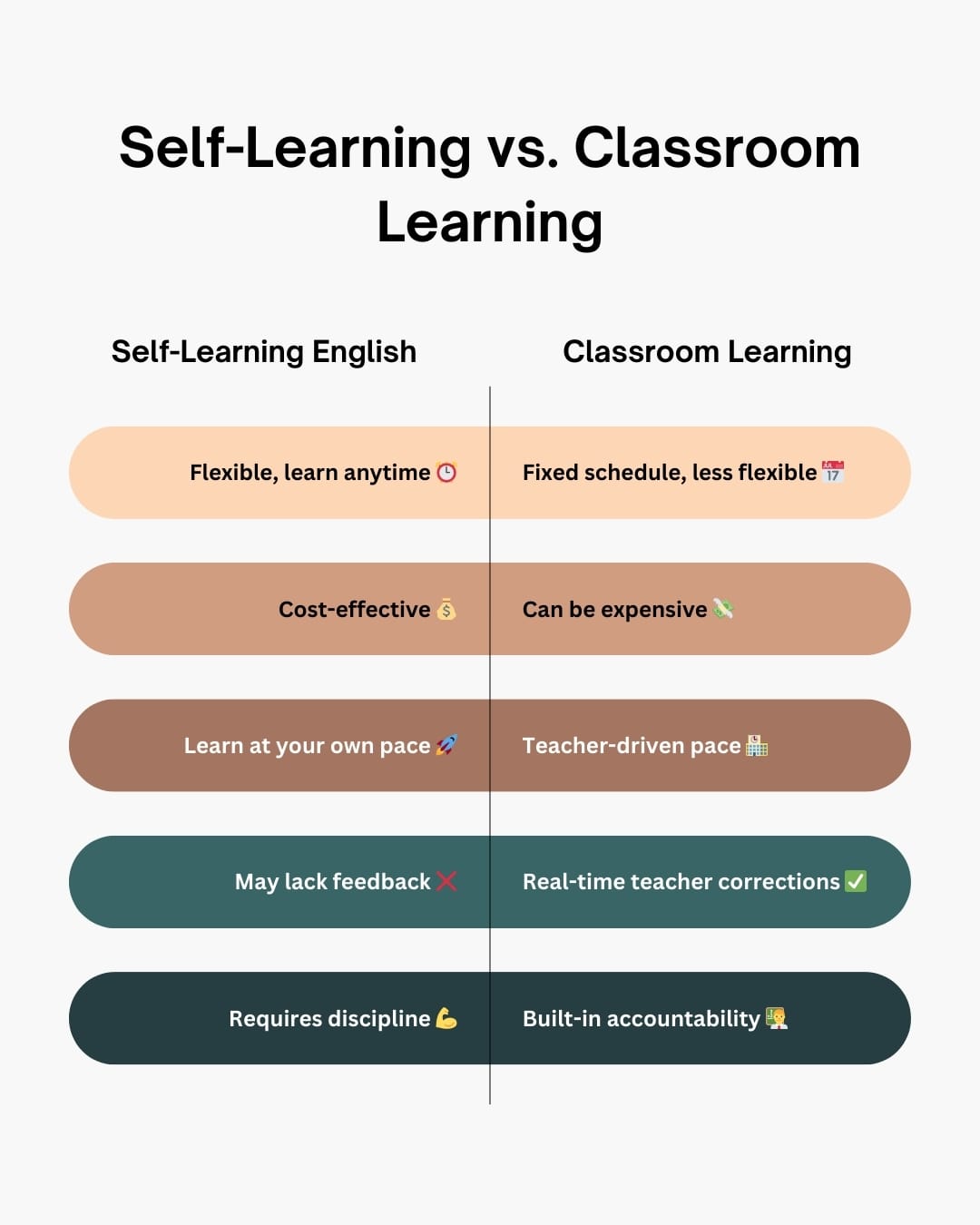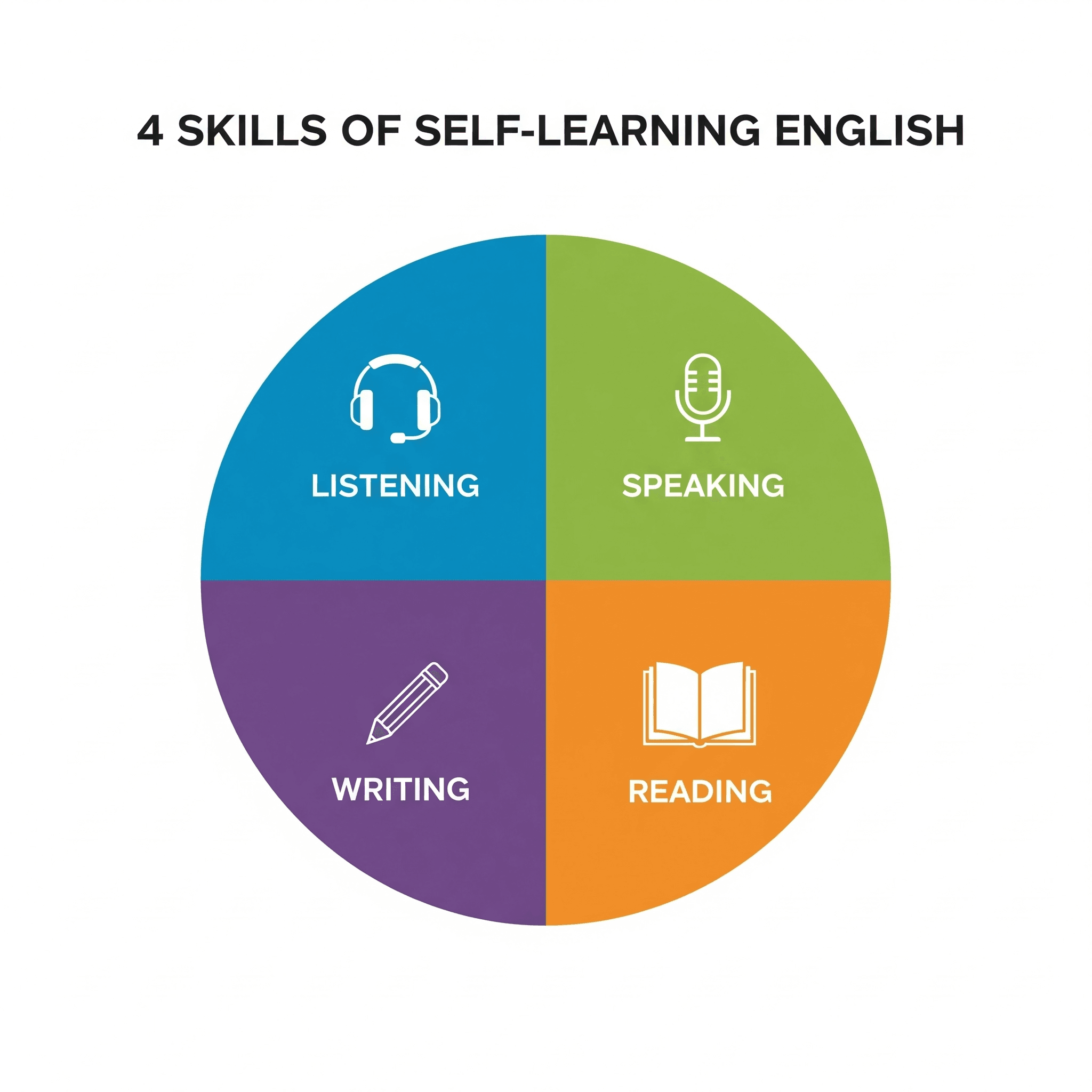Is It Possible to Learn English by Myself? 10 Self-Learning Language Tips
Discover step-by-step strategies, tips, and success stories to self-learning English. This blog gives you solo language tips, structured plans, FAQs, and how Clapingo can help you on your journey.

English Fluency Motivation
Is it really possible to learn English by yourself? Many learners doubt it. They wonder: Without a teacher, will I get stuck? Will I make mistakes forever? The answer: Yes — it is absolutely possible. But it takes planning, consistency, strategy, and the right mindset.
In this post, you’ll get a full guide on self-learning English. We'll cover solo language tips, tools, strategies, mistakes to avoid, and how Clapingo can support your path. By the end, you’ll see: learning English solo is doable, and you can make real progress.
Why Many People Doubt Self-Learning English
Before diving into how, let’s address why this question arises so often.
Lack of guidance. Without a teacher, learners fear they will learn wrong or inefficiently.
Motivation dips. Solo learners may struggle to stay consistent.
Fear of speaking. Many learners stay in “comprehension” mode and hesitate to produce.
No feedback. Mistakes may go unchecked, pronunciation may stagnate.
However, with smart strategies, these obstacles can be overcome. The rest of this guide shows how to turn them into growth opportunities.
Self-Learning English vs Traditional Classes
Here’s a comparison to help you see the pros and cons:
Aspect | Self-Learning English | Traditional Classes |
|---|---|---|
Flexibility | Learn anytime, anywhere | Fixed schedule |
Cost | Usually low or free resources | Higher cost (tuition, books) |
Pace | You control speed | May move faster/slower than your level |
Feedback | You may need external sources or tools | Teacher provides direct corrections |
Customization | You choose topics, methods | Follows curriculum or syllabus |
Responsibility | High (you must stay motivated) | Shared (teacher guides you) |
You’ll see that self-learning gives you flexibility and control — but you also must take on responsibility. Use solo language tips to stay on track.

Clapingo vs Traditional Classes
Mindset & Planning for Self-Learning English
1. Adopt a Growth Mindset
Believe you can improve. Mistakes are part of learning.
View challenges as opportunities, not failures.
Be patient: fluency takes time.
2. Set Clear, Realistic Goals
Break your big goal (“learn English”) into smaller ones:
Short-term goal (3 months): Learn 500 most common words, carry simple conversations, understand basic grammar.
Mid-term goal (6–12 months): Read a simple novel, watch movies with subtitles, speak confidently.
Long-term goal (1–2 years): Think in English, take professional exams (e.g. IELTS, TOEFL), use English at work.
Make SMART goals: Specific, Measurable, Achievable, Relevant, Time-bound.
3. Create a Study Plan
Divide daily/weekly slots:
Daily (30–60 mins): Vocabulary + listening + speaking.
Alternate days: Grammar or reading/writing.
Weekly: Review, test, speak with someone (or record).
Track your progress (use a spreadsheet, journal, or app).
4. Use the “Spiral Learning” Approach
Don’t just study one grammar topic deeply then leave. Revisit topics in cycles, each time in a broader context. Over time, your mastery deepens.

English Self Learning
Methods & Tools for Self-Learning English (Solo Language Tips)
Here are techniques and tools you can adopt when learning English on your own.
1. Use Graded Readers / Simplified Books
Start with books that match your level. Gradual increase in difficulty helps.
Why: You stay motivated, understand more, and gradually pick up new structures.
Tip: Read out loud, circle unknown words, try retelling each chapter.
2. Active Listening & Shadowing
Active listening: Use podcasts, audiobooks, YouTube. Listen carefully, pause, replay, take notes.
Shadowing: Play short audio, then immediately mimic the speaker aloud (speed, intonation). This improves pronunciation, rhythm, and fluency.
3. Speak & Record Yourself
Use voice memos or apps to record yourself speaking.
Compare your voice with native speakers.
Do short monologues (describe your day, plan, tell stories) and improve over time.
4. Use Technology & Apps
Dictionaries / Translators: e.g. Oxford Learner’s, Merriam-Webster.
Language apps: for spaced repetition flashcards.
Chatbots / AI language partners: Talk with AI in English.
Listening tools: Podcasts (e.g. ESL podcasts), YouTube channels, TED talks with transcripts.
5. Use English in Daily Life
Change your phone/computer language to English.
Think in English (label items in your room).
Keep a journal — write short entries daily.
Use social media in English (follow English accounts, post in English).
6. Self-Testing & Quizzes
Create mini quizzes: vocabulary tests, fill-in-the-blanks, grammar.
Use online quizzes or apps.
Test yourself weekly and monthly.
7. Find Conversation Partners (Even as a Solo Learner)
Use language exchange apps.
Join English discussion groups or forums.
If no partner, talk to yourself or to a mirror.
8. Use “Comprehensible Input”
This concept (from language acquisition theory) means you should expose yourself to content just slightly above your current level. It stretches you without overwhelming you.
10 Core Solo Language Tips for Better Progress
Here are 10 actionable solo language tips you can follow:
Learn vocabulary in context. Instead of memorizing isolated words, learn full phrases or collocations.
Use spaced repetition (SRS). Review vocabulary at optimal intervals.
Break tasks into small chunks. 10 minutes of listening beats 1 hour of passive listening.
Mix skills in a session. E.g. read a text, then listen, then speak or write about it.
Use mnemonics. Create vivid associations, images, stories to remember words.
Switch between mediums. Use audio, video, text, conversation to avoid monotony.
Do “productive over passive.” Try to speak or write more than you just read or listen.
Use error logs. Record your mistakes (grammar, vocabulary) and revisit them weekly.
Shadow native speakers daily (brief). Even 5 minutes of shadowing helps daily.
Reward yourself. Celebrate small wins to maintain motivation.
How Clapingo Supports Your Solo Journey
Clapingo is more than just an English program — it can act as your support system when you're learning on your own.
1. Personalized Guidance
Even though you aim to self-learning English, Clapingo can provide you with on-demand expert help. For example:
Ask your doubts to expert tutors
Use feedback sessions to correct pronunciation or grammar
Get customized study plans
2. Structured Practice & Accountability
Clapingo can help you stay accountable. You schedule lessons or check-ins. When you know someone is tracking your progress, you're likelier to stay consistent.
3. Mock Tests & Assessments
Use Clapingo’s assessment tools to gauge your improvement. It helps you know where to improve (listening, writing, vocabulary) rather than just guessing your progress.
4. Resources & Content
Access curated learning modules, quizzes, video lessons, and practice sets. Even in solo mode, you benefit from structured content.
5. Community & Peer Learning
Through Clapingo’s learning community, you can connect with other solo learners, share tips or peer-review each other’s writing or speaking tasks.
Pro Tip: Combine your solo learning blocks with 1 Clapingo session per week. Use that session to clarify doubts, get feedback, and polish your weak areas.
Sample 12-Week Self-Learning English Plan (Using Solo Language Tips)
Here’s a sample schedule you can adapt. You can stretch or compress it based on your pace.
Week | Focus | Daily Activities (30–60 min) | Weekly Task |
|---|---|---|---|
1–2 | Foundations | 20 min vocabulary (common 500 words), 10 min grammar (basic tenses), 10 min listening (simple dialogues) | Record a 2-min self-intro; review error log |
3–4 | Input + output | 15 min reading (graded reader), 15 min listening (podcasts), 10 min speaking shadowing, 5 min writing journal | Write a short story or diary (100 words) |
5–6 | Grammar + fluency | 15 min grammar (conditionals, modals), 15 min listening/news, 10 min speaking (monologue), 10 min vocabulary review | Record a 3-min talk on a topic |
7–8 | Intermediate input | 20 min reading (news, articles), 20 min listening (TED / intermediate podcasts), 10 min shadowing | Summarize an article in 200 words |
9–10 | More output | 15 min speaking practice (with chatbot or partner), 15 min listening, 10 min writing (essay), 10 vocab | Do an online test (e.g. reading + listening) |
11–12 | Polish & review | 20 min reviewing old materials, 10 min speaking recording, 10 min listening, 10 min writing | Do a mock exam; record self speaking for 5 mins |
You can continue further cycles, refining as you go.
Common Challenges & Solutions in Self-Learning English
Challenge: Losing motivation
Solution: Use a “streak” tracker, reward yourself, join a learning buddy or community, set visible goals.
Challenge: You don’t know what to study next
Solution: Use input (e.g. articles, podcasts) to find gaps. Focus on what you don’t yet understand. Use Clapingo or other tutors to get a roadmap.
Challenge: Speaking feels unnatural
Solution: Speak early, even imperfectly. Use shadowing, self-talk, language partners, record yourself and compare. Accept discomfort.
Challenge: Not enough feedback
Solution: Use AI tools to check your writing, get tutors (via Clapingo), ask peers or online communities, record your own voice and compare with natives.
Challenge: Plateauing (no improvement)
Solution: Introduce content above your level, increase challenge, revisit error logs more aggressively, vary your skills combination.
Join a Clapingo demo session and see how fluent you really sound!
Did You Know? (Fun Facts & Motivation)
Did you know?
The average adult native speaker knows ~20,000–35,000 words. But you only need ~2,000–3,000 common words to understand everyday conversations.
Did you know?
Many polyglots claim that “comprehensible input” and “spaced repetition” are the two most powerful tools for language acquisition.
Did you know?
Studies show that speaking (active use) accelerates learning more than passive listening (input) over time.
Did you know?
Even Stephen King writes badly in first drafts — making mistakes is part of every writer’s (or speaker’s) journey.
These facts remind you that learning is gradual and mistakes are normal.

English Self Learning Quick Snapshot
Tips & Tricks Recap
Start small and build habits
Use spaced repetition (SRS) for vocabulary
Use shadowing daily (even 5 minutes)
Speak early, record yourself
Mix input and output in every session
Use error logs to track recurring mistakes
Challenge yourself with content just above your level
Use multiple media (audio, video, reading, writing)
Reward your small wins
Occasionally get external feedback (tutor, community, Clapingo)
Real-Life Examples & Success Stories
“I started learning English by myself during lockdown. I used graded readers, podcasts, and shadowing every day. After 10 months, I could watch Netflix without subtitles. Then I joined Clapingo for weekly feedback — it boosted my speaking skills.”
- Google User Review

Clapingo - The Best Choice for English Improvement
Conclusion
Yes, it is absolutely possible to learn English by yourself. With the right mix of solo language tips, planning, consistency, feedback, and smart tools, you can make real progress. Clapingo can be your ally along this journey by providing structured guidance, assessments, and expert support when you need it.
Start today. Use a small study plan, pick one method, stick with it, track your progress, and speak (or write) early and often.
You don’t need to wait for a perfect teacher or perfect moment. Your solo journey begins with a single daily step. Combine that with Clapingo where needed — and you’ll see how far you can go.
Read Also: Fluent in Any Setting: Learning English Beyond an English-Speaking Environment